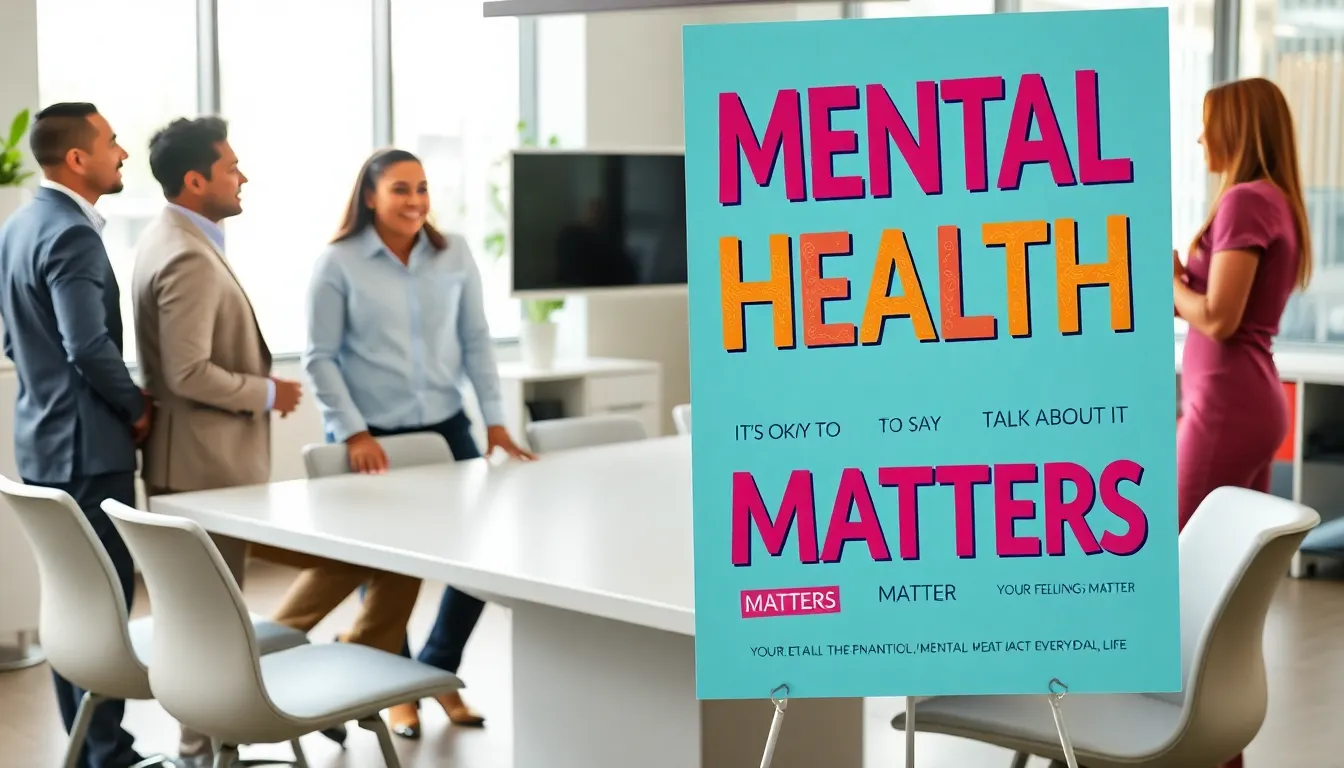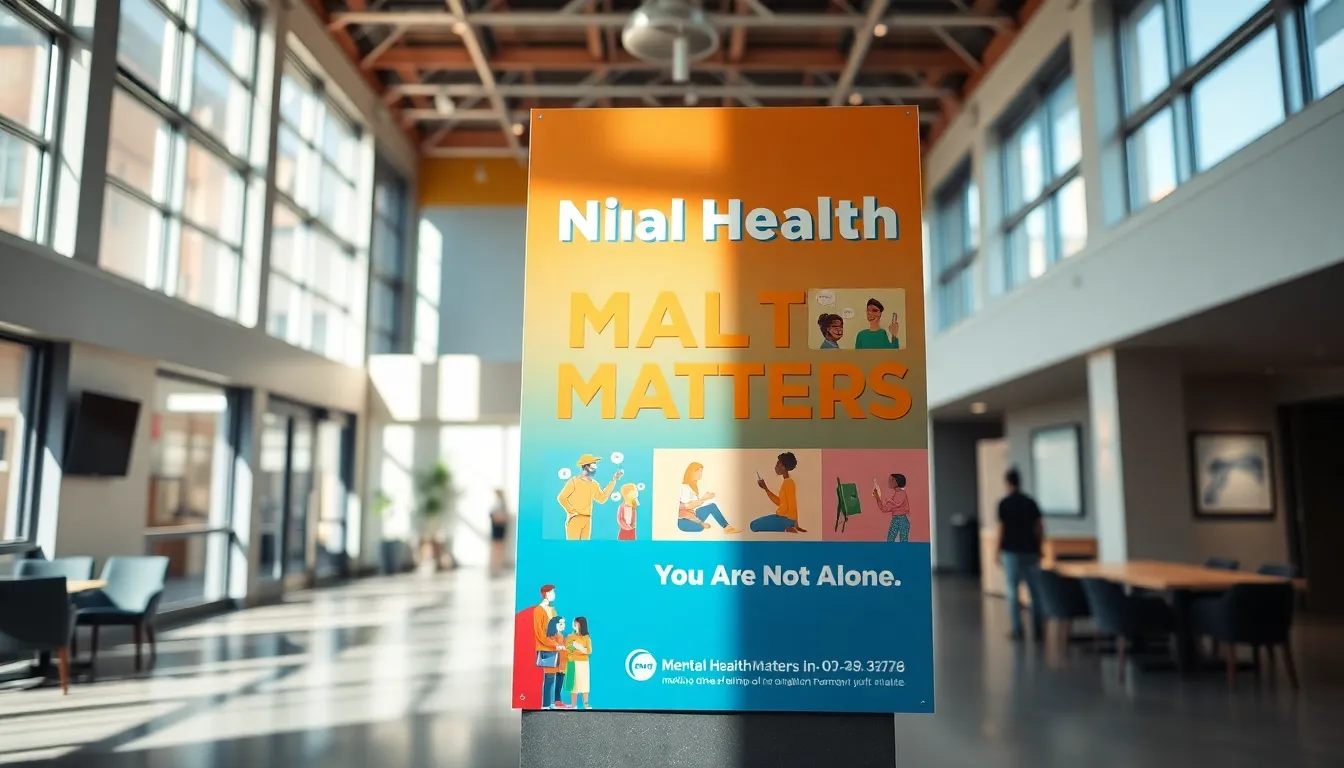Table of Contents
ToggleMental health matters, it’s a statement that should resonate in every corner of society. Imagine walking into a room and seeing a vibrant poster that not only catches the eye but also sparks a conversation. That’s the power of a well-crafted mental health matters poster. It doesn’t just hang there looking pretty: it actively engages, informs, and motivates individuals to prioritize mental health. In a world where the stresses of everyday life can weigh heavily on anyone, such a poster can serve as a gentle yet impactful reminder that mental wellness is critical. So, let’s jump into what makes these posters essential and how they can elevate awareness and understanding of mental health.
Understanding Mental Health

Mental health encompasses emotional, psychological, and social well-being. It affects how individuals think, feel, and act, influencing how they handle stress, relate to others, and make choices. Importantly, mental health is just as vital as physical health, yet it remains stigmatized in many cultures. Mental disorders, such as anxiety and depression, can be debilitating, but understanding and discussing these issues can significantly change the narrative. Start with awareness: knowing that mental health can fluctuate throughout life equips individuals to address their challenges head-on. Learning about mental health gives people the tools to recognize signs, understand their feelings, and seek help when needed.
Importance Of Mental Health Awareness
Promoting mental health awareness isn’t merely a nice-to-have: it’s imperative. Often, mental health issues go unnoticed until they escalate into crises. For instance, a simple conversation about feelings can prevent someone from spiraling into a depressive episode. When organizations and communities prioritize mental health, they cultivate environments where individuals feel safe to express their struggles. This leads to reduced stigma, better support networks, and eventually healthier communities. Posters play a vital role in advocacy. They can catch the attention of passersby and provide essential information at a glance, making them ideal tools for spreading awareness. They remind individuals that it’s perfectly okay not to be okay.
Design Elements Of A Mental Health Matters Poster
A successful mental health matters poster consists of various design elements that come together harmoniously. Here are some essential components to consider:
- Color Scheme: Colors evoke emotions. Bright and vibrant colors can inspire happiness and positivity, while softer hues can create a calming effect. Choose shades that convey the message you want to communicate.
- Images and Graphics: Striking visuals are key. Images that depict contentment, community, or support can resonate deeply. Illustrations, icons, or even infographics can quickly convey complex messages in a digestible format.
- Typography: Ensure the font is legible and welcoming. Big, bold letters can grab attention, while softer typography can make the message feel more personal and inviting.
- Layout: A clutter-free design aids readability. Use adequate spacing and organization to ensure that viewers can absorb the information quickly.
- Call to Action: Don’t forget to include a clear call to action (CTA). Encourage viewers to reach out for help, share their story, or get involved in community mental health initiatives.
Key Messages To Include
In crafting your mental health matters poster, it’s vital to concisely communicate impactful messages. Here are several key messages that should be incorporated:
- It’s Okay to Ask for Help: Normalize seeking assistance when feeling overwhelmed.
- You Are Not Alone: Remind individuals that many struggle with mental health issues,
fostering a sense of community.
- Promote Self-Care: Highlight the importance of taking time for oneself, be it through relaxation, hobbies, or therapy.
- Mental Wellness is a Journey: Encourage individuals to view their mental health as an ongoing process rather than a fixed state.
- Resources Available: Provide contact information for local mental health services, hotlines, or support groups. This creates a direct connection to help.
Distributing And Displaying Your Poster
Once the poster is designed, the next step involves thoughtful distribution and display. Here are some effective strategies:
- Community Centers: Post your materials in areas frequented by diverse groups: this increases visibility.
- Schools and Universities: Educational institutions are ideal spots to raise awareness among students, faculty, and families.
- Local Businesses: Partner with coffee shops, gyms, and libraries to showcase your poster, tapping into various community segments.
- Online Sharing: In today’s digital age, consider creating a virtual version. Social media platforms can spread awareness across a larger network, reaching individuals who may not see physical posters.
- Participate in Events: Attend health fairs or community gatherings. Distributing your posters at these events can help draw attention and start conversations.
Measuring The Impact Of Your Poster
After distribution, evaluating the impact of your mental health matters poster is crucial. Here’s how to assess its effectiveness:
- Collect Feedback: Encourage discussions after displaying the poster. Surveys or feedback forms can help gauge viewer reactions and thoughts.
- Track Engagement: If the poster includes QR codes or URLs, metrics from these can reveal how many people engaged with the resources listed.
- Community Response: Monitor responses from the community. Are people discussing mental health more openly? Are they seeking help?
- Before and After Studies: If feasible, conduct a community assessment before and after the poster is displayed to evaluate changes in awareness or behavior about mental health.



